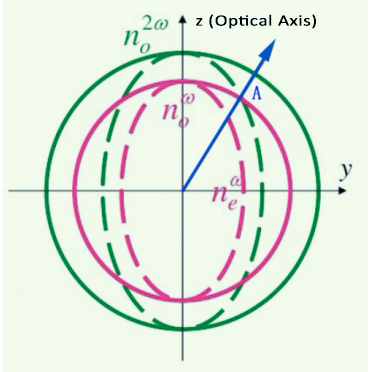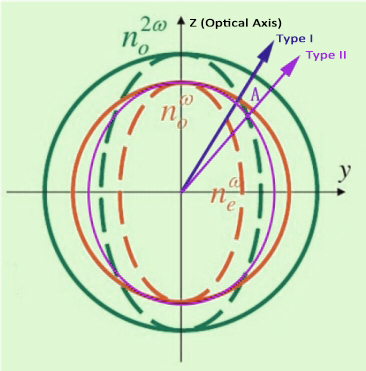Harmonic Generation
▶Introduction
What are the Optical Harmonic Generation (or Nonlinear Frequency Conversion) technologies?
The essential concept of harmonic generation is the conversion of the input light to light of other frequencies, using the optical nonlinearities of certain materials with nonlinear effects. As an important branch of laser and nonlinear optics, the nonlinear optical harmonic generation technique is the most effective technical means to obtain multi-wavelength and tunable femtosecond lasers.
What are the merits of harmonic generations? Because optical harmonic generation refers to the multiplication of the frequencies of electromagnetic waves, with higher frequencies, the wavelengths of the laser are shorter, and the period of the electromagnetic wave will also shrink, leading to higher energies of the electromagnetic waves. As a result, the stronger the particle nature of the laser causes stronger penetrating power. Therefore, the shorter cycle of transmitting the complete electromagnetic wave contributes to a shorter laser pulse duration.
In recent years, along with the research of new lasers and the gradual maturities of nonlinear crystal preparation technology, nonlinear optical harmonic technology has also been developed rapidly. At present, using SHG/frequency doubling, (it is worth noting that currently, second harmonic generation, or SHG is one of the most prevalent methods used if you want to learn more about SHG, we have posted a separate article to Explanation of SHG more profoundly, you could click to view more), THG/frequency tripling, 4HG/frequency quadrupling, 5HG/fifth harmonic generation, sum and difference generation, and OPA/OPO. The frequencies laser wavelengths s far can cover the spectral range from the vacuum ultraviolet to mid-infrared, and can even be extended to soft x-ray and terahertz wavelength bands using the nonlinear frequency conversion measures.
Below is a brief short history of the advent and development of harmonic generation. In 1961, Franken and other scientists used a ruby laser (694.3 nm) to focus on a quartz crystal to obtain a frequency-doubled violet light of 347.1 nm. This is the first time that lasers interact with crystals to produce nonlinear effects, marking the real beginning of nonlinear optics. In 1962, Maker and his group of researchers proposed phase-matching technology, which greatly improved the conversion efficiency of the nonlinear transformation process. In the same year, Armstrong, Bloembergen, Ducuing, and Pershan issued a complete thesis on nonlinear optics, which laid a theoretical foundation for the development of nonlinear frequency conversion technology.
▶Nonlinear Optical Effects
First, we got to learn Optical Nonlinear Effects, which are of significant importance to optical harmonic generation/nonlinear frequency convention. Nonlinear optics is special research on nonlinear phenomena and media applications under strong coherent and intensive light. The research of nonlinear optics has eminent significance for laser technologies, spectroscopies, and material structure analysis. Before the advent of the laser, it was just to observe the propagation of weak light beams in the medium. Next, ensure that the polarization intensities of the medium were proportional to the intensities of electric field E of the light wave, and the principle of linear superposition was followed when the light waves were superimposed. Researching the thesis mentioned above under controlled conditions is called linear optics. However, for instance, when the incident lasers are intense, which means the electric field strength of the light wave can be compared with the Coulomb field inside the atom, the interaction between light and the medium will produce nonlinear effects and the scientific quantities that reflect the properties of the medium (such as polarization, etc.) are not only related to the field, which is relevant to the first power of strong E, but also depends on the higher power term of E, which is the nonlinear optical effect. Therefore, the optical nonlinear phenomenon is a phenomenon that is produced by electromagnetic radiation, but its response is not proportional to illuminance.
▶Nonlinear Optical Crystals
At present, the utilization of Nonliner Crystal is still the main measure to obtain ideal wavelengths which are formerly impossible, including second-order NLO crystals and even third-order NLO crystals. With the unceasing efforts of the cultivation of scientists in the field of harmonic generation worldwide nonlinear crystals are Beta Barium Borate (BBO) Crystals, DKDP (KD*P) Crystals, KTP Crystals, LBO Crystals, etc. Nonlinear crystals are an important kind of optical crystal material to realize harmonic generations and OPO/OPA, being capable of amplitude modulation, polarization modulation, and phase modulation of the laser beam. Nonlinear crystals are a critical kind of optical media often used in lasers. As laser equipment is widely used in industrial, agricultural, defense, medical and other purposes, the development of new nonlinear crystals has become a frontier and hot topic in the field of international optoelectronic technology and new material technologies.
The major purpose of phase matching (taking SHG as an example, that is, the frequencies of light is doubled) is to let the light of fundamental frequencies propagate in the crystal, and then excite the frequency-doubled light along the way. Take the example of second harmonic generation, since the phase velocity is the same, the phase is consistent, so along the way The excited frequency-doubled light can meet the interference conditions, thereby greatly enhancing the light intensity of the frequency-doubled light. The entire course is based on the nonlinear optical effect.
▶Type I Phase Matching
Both Type I and Type II (if you are interested in Phase Matching, click to learn), Phase matching utilizes the birefringence of certain crystals. As shown in Figure 1 below. The solid circle in the figure represents o light, and the dotted ellipse represents e light. We know that the propagation speed of o light in each aspect is the same, and the propagation speed of e light is different. Also, it’s worth accentuating that the propagation speeds of light of different frequencies in materials are also different (classic dispersion phenomena such as rainbows, etc.). Our purpose here is to use the fundamental frequency light to generate frequency doubled light, so basically it’s just a matter of aligning the intersection point A where the red circle meets the green dotted ellipse so that the o light of the fundamental frequency light can generate the frequency doubled e light of, letting the small circle becomes the larger ellipse. To be concise, the course is using 2 o-photons of the fundamental frequency to transform into 1 e-photon of double-frequency light.

Figure 1. Diagram showing Type I Phase Matching
▶Type II Phase Matching
The phase matching method mentioned above, we call it type I matching, this type takes the same polarized light of the fundamental frequency light. If there is Type I, there will naturally be Type II. Type II matching should take differently polarized light of the fundamental frequencies. How to do it? As shown in Figure 2, the refractive index of e-light and o-light are fixed, hence it must be possible to find such a point so that the circle intersects with the dotted ellipse. This direction is the direction along which the light incident upon the nonlinear crystal. The essence of type II matching is that one e-light fundamental-frequencies and one o-light of fundamental frequencies are converted into frequency-doubled e-light.

Figure 2. Diagram showing Type II Phase Matching
In addition to type 1 and type 2 birefringent phase matching, the methods of phase matching are very diverse, including noncritical temperature matching, quasi-phase matching, etc.
▶Optical Parametric Amplification (OPA) and Optical Parametric Oscillation (OPO)
Optical Parametric Amplification (OPA) takes place when a high-power laser beam (referred to as the pumping source) with angular frequency ωp is incident on a nonlinear crystal, resulting in gains at two lower frequencies (ωs and ωi, and ωs+ωi=ωp), and amplification of the light beams of corresponding frequencies. The gain is maximized when the phase-matching condition is met. If a beam of frequency ωs (signal wave) is incident on the nonlinear crystal, its light intensities will be amplified, at the same time, a coherent light (called the idle wave) will be generated at the frequency ωi. This is the process of optical parametric amplification. From the perspective of photonics, this is a process in which the photons of the pump light are annihilated to generate two low-frequency photons (corresponding to signal wave and idle wave, respectively).
Optical Parametric Oscillation(OPO) is laser oscillation generated using parametric amplification. The working principle is quite similar to that of OPA. The nonlinear medium is placed in the resonant cavity, and the pump light wave, signal light wave, and idle light wave pass through the nonlinear medium multiple times. When the loss inside the resonant cavity is outnumbered by the gain of signal wave and idle wave due to OPA, optical parametric oscillation is formed in the resonant cavity.
So far, OPO can achieve continuous and stable operation in continuous, quasi-continuous, nanosecond pulse to femtosecond pulse states, and has a wide range of applications in spectroscopy, biomedicine, remote sensing detection, and environmental monitoring.
Prospect of OPO in the MarketIn 1965, J.A.Giordmaine and R.C.Millerz reported the advent of the first OPO, they used the nanosecond Nd3+:CaWO4 laser to pump the bulk lithium niobate crystal and obtained a tunable laser output of 0.97-1.15μm. In the next 20 years, OPO technology developed rather moderately. In the 1980s, a major breakthrough was made in the workshop of nonlinear crystals and the successful development of femtosecond lasers accelerated the research on OPO, especially in femtosecond pulsed OPO.
The first in synchronously pumped femtosecond pulsed OPO was reported by D.C.Edelstein. in 1989. They used a collision pulse mode-locked dye femtosecond laser to pump KTP crystals and realized the 820-920 nm and 1.90-2.54μm femtosecond pulse and continuous tunable.
▶Nonlinear Frequency Conversion and Femtosecond Lasers
Femtosecond lasers have a pulse width of hundreds of femtoseconds. From the perspective of the development of nonlinear crystal materials, the utilization of new nonlinear crystals (such as LBO, BBO, etc.) and PPKTP, etc. are exponentially improving and expanding the output efficiencies and spectral range of OPO, and can now cover from ultraviolet to mid-far infrared and even terahertz bands.
From the perspective of the development of pumping sources, the invention of femtosecond lasers has further encouraged the development of nonlinear harmonic generation. In general, there are two kinds of ultrashort pulse pumping sources during the conversion of frequencies: solid-state femtosecond lasers, and fiber femtosecond lasers. Ti:Sapphire is one of the most common solid-state femtosecond lasers, however, due to the thermal effect of solid-state lasers, extra temperature control devices such as water cooling are required, which makes this laser ponderous in size and complex in the optical path. Moreover, the average output power of Ti:Sapphie of laser is Low, generally below 2.5 W, which limits its development in the nonlinear field.
Compared with solid-state femtosecond lasers, fiber femtosecond lasers have the advantages of lower cost, more compact structure, simple operation, and good heat dissipation. What’s more, the photonic crystal fiber with a large mode field area can overcome the limitation of high-power operation due to the nonlinear effect resulting from the high laser power density, so the photonic crystal fiber femtosecond laser with a large mode field area is a good pump source for nonlinear frequency conversion.
▶About us
Hangzhou Shalom EO offers ultra-thin BBO crystals designed for femtosecond lasers and a broad portfolio of various nonlinear crystals, such as LBO, DKDP, KTP, etc. With over a decade of experience, precision polishing techniques, sincere customer service, and strict inspection in a clean room, Shalom EO has erected a trusted image among global customers.
Related Articles
Tags: What is Harmonic Generation

